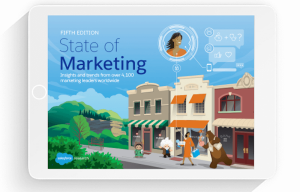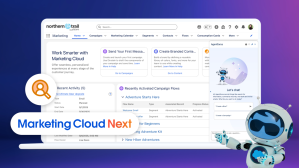Today, Salesforce released the fifth edition of its State of Marketing report, sharing insights that provide marketers with the necessary considerations and guidance they need for 2019. Based on a survey of more than 4,100 marketing leaders worldwide, the report reveals that marketers increasingly prioritize personalization, leverage the power of artificial intelligence (AI) and turn to numerous data sources to improve customer engagement. However, they’re challenged with earning customer trust and respecting privacy. Marketers’ use of AI has grown at a rate of 44 percent since 2017, but as personalization improves, only 30 percent of marketers are completely satisfied with their ability to balance it with privacy.
The Salesforce State of Marketing report focuses on these four emerging trends:
Marketing is at the Center of Connecting Customer Experiences
Customer expectations are at an all-time high. In this new reality, marketers are increasingly responsible for meeting customer demands. It’s no wonder that more than half (54%) of high-performing marketers—those that are completely satisfied with their overall marketing performance and the outcomes of their marketing investments—say their organization is leading customer experience initiatives across the business.
- Top marketing teams stay aligned. Sixty-five percent of marketing leaders say all team members within their organization share common goals and metrics.
- Marketing and commerce teams are increasingly connected. In fact, 50% of marketing and commerce teams share common goals and metrics.
- Marketing and sales team are collaborating more frequently. More than half (54%) of marketers feel empowered to collaborate with sales teams, and 52% share common goals and metrics.
- Of all departments, marketing and service work closest together. Fifty-five percent of marketing teams collaborate with service teams to manage and respond to inquiries and issues over social media, 54% have a free and open flow of customer data between teams and 53% share common goals and metrics.
More Customer Data Sources Up the Ante for an Identity Resolution
Marketers turn to an abundance of data sources to better understand customer preferences. Everything from email open rates to web activity to demographics help marketers paint vivid pictures of their customers, but all of this data often lives in siloed technologies and is difficult to unify.
- The median number of data sources—defined as any source of personally identifiable data on customers that can be used to inform marketing strategies and tactics—is forecasted to jump from 10 in 2017 to 15 in 2019, but only 47% of marketers say they have a completely unified view of customer data sources.
- The top four technologies used to solve for customer identity are marketing databases, customer relationship management (CRM) systems, email service providers (ESPs) and data management platforms (DMPs).
- The DMP has transcended its traditional use case of managing cookie IDs to generate audience segments for digital advertising. In the next two years, marketers are planning to use DMPs for audience insights, audience discovery and segmentation, identity resolution and management, creative testing and optimization and content personalization.
AI Powers Personalized Marketing at the Crossroads of Trust
Personalization is key to achieving all marketing objectives, including brand building, lead generation and customer acquisition. The power of AI enables marketers to better identify customers and engage them with the right information across all channels, which is the core of great marketing. At the same time, marketers are increasingly taking into account customer trust and privacy, as they recognize that their success depends on it.
- High-performing marketers have been at the forefront of AI adoption with 40% of them using it in 2018. When looking at all marketers, 29 percent used AI in 2018–up from 20% from 2017.
- Marketers are seeing more opportunities to use AI. Today, most marketers use AI in two different ways, such as powering real-time next best offers or predictive marketing journeys. By 2020, most marketers will use AI an additional four ways, including personalizing customer journeys and creating dynamic landing pages and websites.
- Recent privacy regulations have made trust a marketing imperative. Fifty-one percent of marketing teams say they’re more mindful about balancing personalization and privacy than they were two years ago.
Marketers Continue to Strive for Real-Time Customer Engagement
Real-time customer engagement ranks as the top marketing priority, and the top marketing challenge. Marketers know that every marketing communication should build upon the last customer interaction, which means that the campaigns they deploy need to be dynamic. But, surfacing the most relevant next-best marketing message regardless of channel is easier said than done.
- Only 28% of marketers are completely satisfied with their ability to engage with customers across channels at scale.
- Two-way engagement (in which a marketers adjust strategy and tactics based on customer actions) is now commonplace. Fifty-two percent of marketers adapt marketing strategy and tactics based on how a customer interacts with their content.
- Marketers’ ability to engage dynamically across channels (or evolve from channel to channel based on customer actions) is nascent. Only 32% of marketing leaders say a given channel is dynamically coordinated with others, up from 28% in 2017.
Additional Information
- Check out the blog post for a deeper analysis on the report’s findings here.
- Download the fifth edition of the Salesforce State of Marketing report.
- Learn more about the Salesforce Customer Success Platform.
- Learn how to make your marketing strategy smarter with Trailhead.
Connect with Salesforce
- Like Salesforce on Facebook http://facebook.com/salesforce
- Follow @salesforce @marketingcloud on Twitter
Methodology
This study was conducted by Salesforce Research through a third-party survey firm in August and September 2018. Four thousand-one hundred and one full-time marketing leaders in Australia, New Zealand, Belgium, Brazil, Canada, France, Germany, Hong Kong, India, Ireland, Japan, Mexico, the Netherlands, the Nordics (Denmark, Finland, Norway and Sweden), Singapore, the U.K. and the U.S. were surveyed. Respondents were segmented into high-performing, moderate-performing or underperforming groups.
























